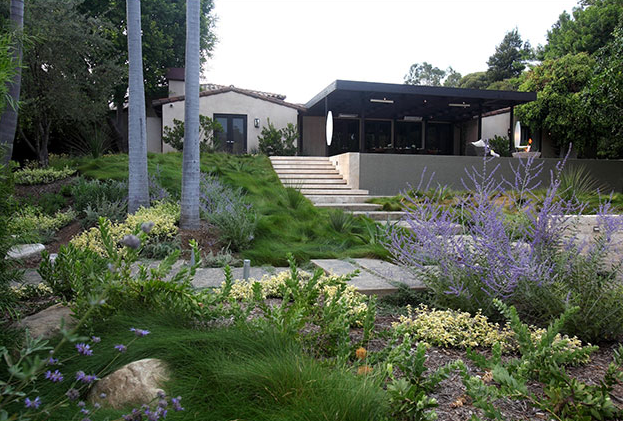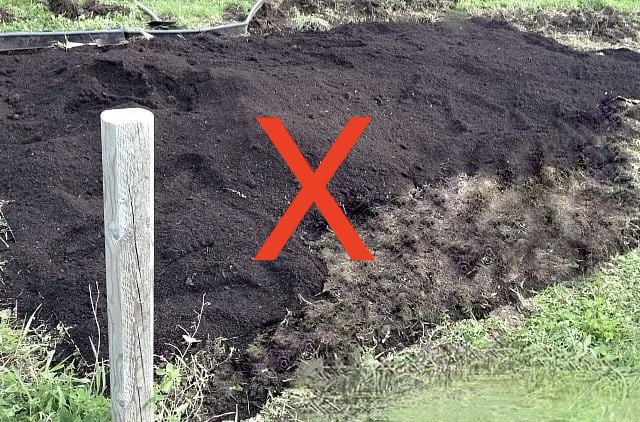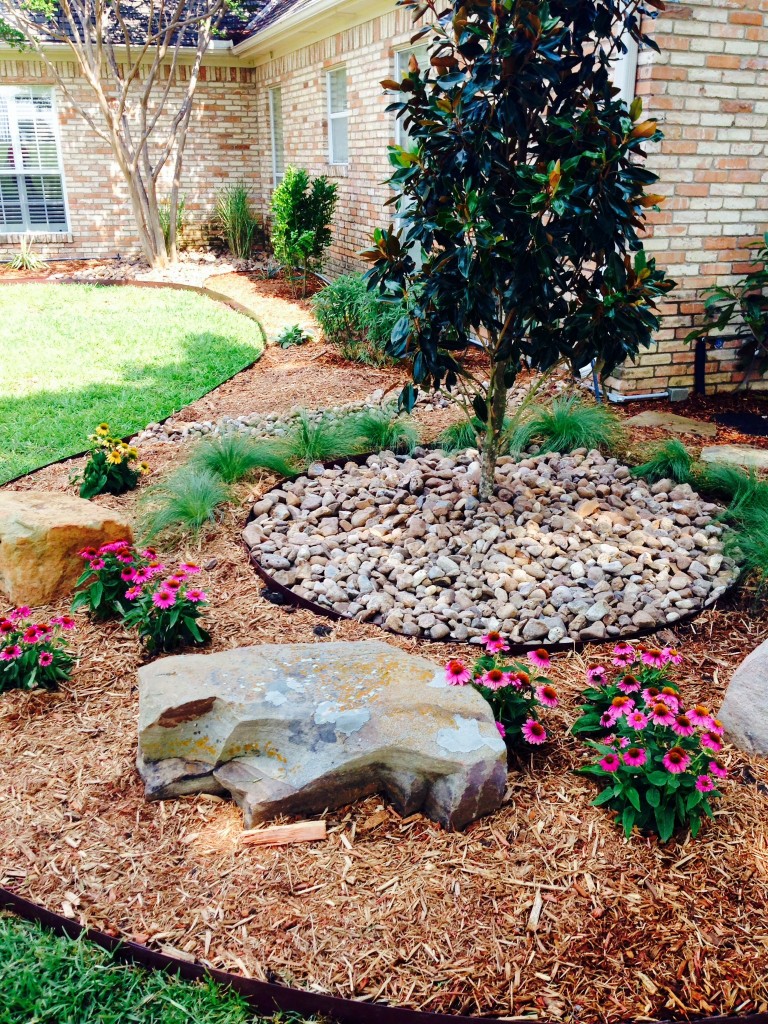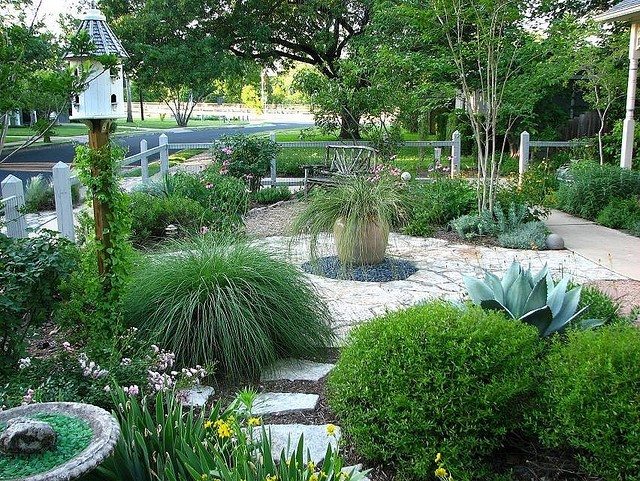With drought conditions or lower than average precipitation becoming more widespread across the country, it’s time to revisit the principles of xeriscape gardening. Let’s take a look at the “classic” principles and we’ll update them, Garden Professor style.
Note: If you’re growing food crops to supply your table not all of these principles will apply. Some will, e.g mulching, and some won’t. This blog post is focused on ornamental landscaping.

SO WHERE DID IT ALL BEGIN?
As an “official” landscaping technique xeriscaping seems to have begun in the early 80’s. Denver Water, the largest and oldest public water utility in Denver, Colorado, coined the term xeriscape in 1981 by combining “landscape” with the Greek prefix xero-, meaning ‘dry’. The utility then began to formally define the main principles of xeriscaping for members of the Denver community interested in modifying gardening practices to save water. The results were the Seven Principles of Xeriscaping, listed below.
THE SEVEN PRINCIPLES OF XERISCAPING
1. Sound landscape planning and design.
2. Limitation of turf/lawn to appropriate, functional areas.
3. Use of water efficient plants.
4. Efficient irrigation.
5. Soil amendments.
6. Use of mulches.
7. Appropriate landscape maintenance.
Let’s review them and apply some up-to-date gardening information.
1. “Sound landscape planning and design” – the ideal starting point for all gardens, “Right Plant, Right Place.” This principle earns a GP thumbs-up.

2. “Limitation of turf/lawn to appropriate, functional areas” – turf has a place in the landscape but perhaps not everywhere or in every landscape. “Right Plant, Right Place” (hmm, that sounds familiar). Another GP thumbs-up.

3. “Use of water efficient plants” – it may be stating the obvious but you want water efficient plants that work in your grow zone or micro-climate. Do some homework and choose plants that will be happy in your region. We’ll give this one a GP “OK” with a few points lost for being vague.

4. “Efficient irrigation” – this one has always been a puzzler. Perhaps it was included for folks who can’t break the habit of watering their gardens. The goal of xeriscaping is to have a landscape that does well on the average precipitation of an area. Granted in times of drought some plants may need a good drink now and then and new plants may need help getting established. But for the most part watering should be at a minimum and at the correct time, seasonally as well as weekly or monthly. Don’t forget to include any natural slope and drainage in your efficient irrigation plan. And “efficient” includes a correctly working automated system if you use one. This gets a GP “OK” as well.

5. “Soil amendments” – We now know that amending the soil is not a recommended practice. It interferes with drainage, causes soil subsidence and is not conducive to root growth. Plants need to be planted in native soil, whatever it may be. This one gets a big “F” for Fail and shall be removed from our list.

6. “Use of mulches” – if you’ve been following the Garden Professors blog you’ll know this is a winner. You also know that, ideally, we recommend using arborist chips but we also know that not everyone has access to them. Mulch choice also depends on the landscape site, plant choice and, in many instances, local codes. An organic mulch (but not bark) is usually the best bet, but there are times when an inorganic rock mulch is desirable. Do your homework and choose the best mulch for your situation. Mulch!
This xeriscape principal gets the GP Seal of Approval.

7. “Appropriate landscape maintenance” – too often xeriscapes are advertised as “maintenance free”; this is false. Like all landscapes and gardens xeriscapes are an artificial environment and require maintenance to thrive. Established xeriscapes will, hopefully, need less maintenance but they do need care. This can include dealing with weeds, regular inspection and maintenance of an irrigation system, and regular plant husbandry items such as pruning and clean up. This gets a GP thumbs-up.

So, based on the above discussion, here are The Garden Professor’s Principals of Xeriscape, Revised Version
THE SIX PRINCIPLES OF XERISCAPING
1. Sound landscape planning and design.
2. Limitation of turf/lawn to appropriate, functional areas.
3. Use of water efficient plants.
4. Efficient irrigation.
5. Use of mulches.
6. Appropriate landscape maintenance.
Looking over these principles we see no reason why they can’t be applied in every region and in every landscape. Learning to garden with what you have and where you are is the hallmark of a wise gardener.
Garden smarter, not harder.

I am wondering about #5.no longer amending soil .
Is it your belief that putting a plant based compost onto your soil is a harmful thing to our environment?
I can see how transporting soil from one location to another could be detrimental.
I see the use of composted plant matter very much like what nature does .
Could you please clarify for me?
Amending means working into the soil. We recommend mulching, or topdressing, as amending soil damages its structure and creates textural interfaces. But before adding compost or any other nutrient-rich organic material you really need a soil test to determine if there is any need for those nutrients.
We have solid red clay. We have plenty of water all year except sometimes a lack of rain in August.
The rule of thumb is you are stuck with the soil you have. The way to improve it is through an organic mulch layer. Working amendments into the soil does not work. Arborist wood chips will vastly improve the tilth of your clay soil (which is probably heavily compacted as well).
A timely piece on xeriscaping.
I’m wondering why there’s no mention of site conditions regarding amount of sunlight, since this approach is primarily associated with full-sun, relatively dry habitats with site appropriate plants adapted to these conditions.
Dry shade gardens are more likely to be modelled on dry woodland habitats, not xeriscapes.
You might want to figure this into your criterion.